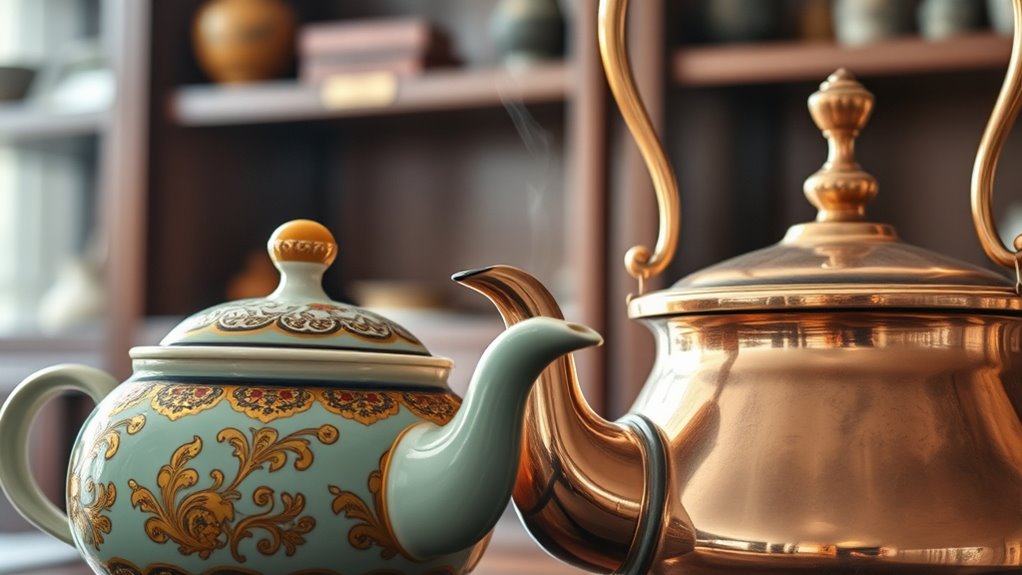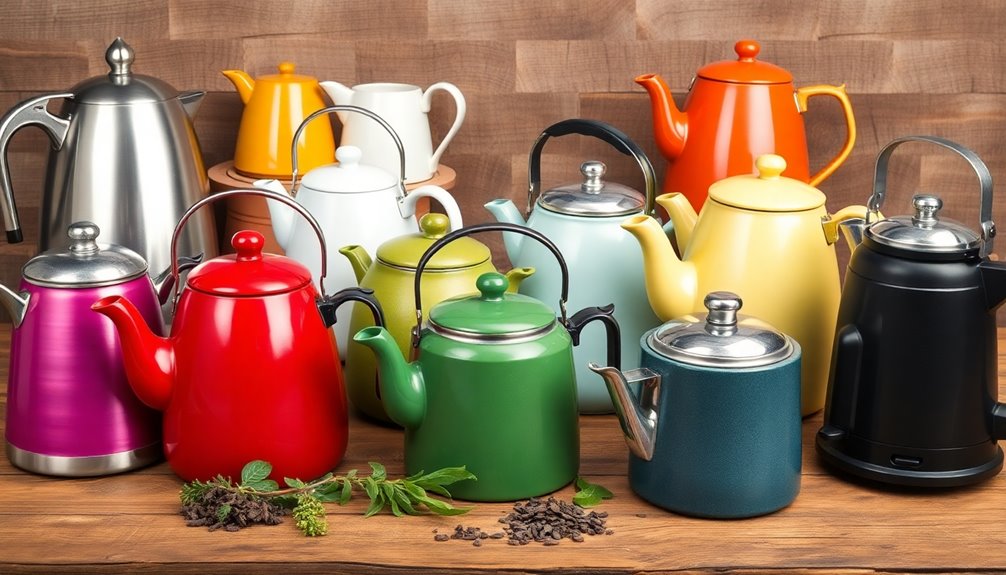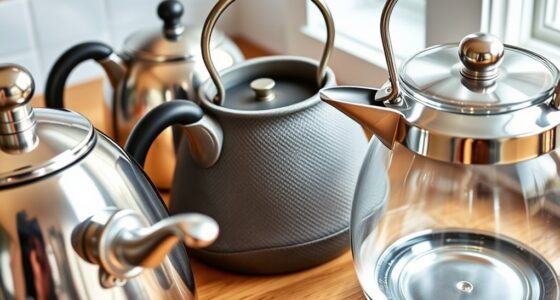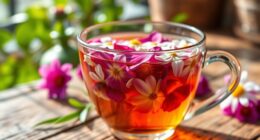Tea kettles and teapots hold deep cultural meaning, symbolizing social bonds, tradition, and artistry worldwide. They reflect centuries of history, serving as vessels for rituals that emphasize respect, mindfulness, and community. From Asian tea ceremonies to Western comfort gatherings, these objects reveal cultural values and social hierarchies. Their craftsmanship and symbolism connect us to the past while enriching present traditions. To explore the rich stories behind these cherished items, keep discovering their fascinating significance.
Key Takeaways
- Tea kettles and teapots symbolize cultural heritage, tradition, and social connection across many societies.
- They play a central role in rituals and ceremonies that emphasize respect, mindfulness, and community bonding.
- Regional designs and craftsmanship reflect local philosophies, artistic values, and historical practices.
- Sharing tea with these vessels signifies hospitality, friendship, and social hierarchy.
- In Western cultures, they represent comfort, leisure, and the preservation of cultural identity.

Have you ever wondered why tea kettles and teapots hold such cultural importance across different societies? These humble vessels go beyond their practical use; they embody centuries of tradition, artistry, and social connection. In many cultures, the act of preparing and serving tea is deeply rooted in history and reflects a community’s values. The tea ceremony, for example, isn’t just about drinking tea—it’s a ritual that emphasizes mindfulness, respect, and harmony. It’s during these ceremonies that teapots and kettles become symbols of cultural heritage, representing more than just a means to brew a warm beverage.
Across Asia, particularly in China and Japan, the tea ceremony is considered an art form. The choice of teapot, its material, and design are deliberate, often reflecting regional styles and philosophies. For instance, Japanese tea ceremonies utilize specific teapots that promote even heat distribution, enhancing the flavor of delicate green teas. In China, the yixing teapots are prized for their ability to develop a seasoned patina, adding to the tea’s depth. These vessels aren’t just functional; they’re crafted with care, often by skilled artisans whose techniques are passed down through generations. The teapot becomes a vessel of tradition, carrying stories and cultural values with every pour.
Japanese tea ceremony teapots enhance flavor through precise heat, embodying regional artistry and tradition.
Furthermore, the cultural heritage associated with tea kettles and teapots is evident in their symbolism. They often symbolize hospitality and social bonding, especially in societies where sharing tea signifies respect and friendship. The way a tea is prepared and served can reveal social hierarchy, etiquette, and reverence for tradition. In many cultures, the ritual of boiling water in a traditional kettle and pouring it into a beautifully crafted teapot elevates a simple act into a meaningful experience. These rituals serve to preserve cultural identity and connect individuals to their history. Additionally, the craftsmanship involved in making these vessels reflects a respect for artistic tradition and meticulous skill passed through generations.
In Western societies, the teapot has evolved into an icon of comfort and tradition. It’s associated with leisurely afternoons, family gatherings, and cozy conversations. While the cultural depth may differ, the essence remains the same: tea vessels act as a bridge to cultural heritage, allowing people to honor their roots. So, when you see a teapot or kettle, recognize that it’s more than just a tool—it’s a symbol of cultural identity, a keeper of history, and a facilitator of social bonds. It’s through these humble objects that societies express their traditions, values, and collective memory.
Frequently Asked Questions
How Do Different Cultures Influence Teapot and Kettle Designs?
You see that different cultures influence teapot and kettle designs through cultural symbolism and design evolution. For example, Chinese teapots often feature intricate patterns reflecting history and philosophy, while British kettles emphasize practicality with sleek, modern shapes. These designs adapt over time, blending traditional elements with contemporary trends, highlighting how cultural values shape both aesthetics and functionality. Your appreciation grows as you recognize these subtle, meaningful influences in every piece.
What Are the Symbolic Meanings Attached to Specific Tea Kettles?
You might be surprised to discover that specific tea kettles carry profound symbolic meanings. Historically, some kettles represent prosperity, while others embody spiritual renewal. For example, a finely crafted, ornate kettle can symbolize wealth and status, whereas a humble, simple design might signify humility and spiritual purity. These symbols connect deeply to cultural beliefs, shaping how you view and cherish your teapot, revealing a rich history that adds depth to every brew.
How Have Modern Materials Changed Traditional Teapot Craftsmanship?
Material innovation has transformed traditional teapot craftsmanship by introducing modern materials like stainless steel, glass, and silicone, making them more durable and functional. You’ll notice a design evolution as these new materials allow for sleeker, more versatile shapes and features that suit contemporary lifestyles. This shift improves heat retention, ease of cleaning, and aesthetic appeal, blending tradition with innovation to enhance your tea experience while respecting classic craftsmanship.
Are There Rituals Associated With the Use of Tea Kettles Worldwide?
Imagine you’re in a traditional Japanese tea ceremony, where every step involves specific tea preparation rituals with a beautifully crafted teapot. Across the world, many cultures have ceremonial tea serving practices—like China’s Gongfu tea or British afternoon tea—that elevate simple tea drinking into a meaningful ritual. These rituals often involve precise gestures, timing, and respect, transforming tea preparation into a spiritual experience that fosters connection and mindfulness.
How Do Tea Kettles Reflect Social Status in Various Societies?
You see that in many societies, tea kettles mirror social hierarchy and economic class. Fancy, ornate kettles often belong to the upper class, symbolizing wealth and status, while simpler designs are common among the working class. By choosing specific styles or materials, you can subtly display your social standing, making the tea-making process a reflection of your place in society.
Conclusion
Just as a master painter’s brush brings a blank canvas to life, your teapot and kettle shape moments of connection and tradition. They’re like silent guardians, holding stories and rituals that flow like warm tea, warming both your hands and heart. Remember, each pour is a gentle ripple in the pond of culture, reminding you that in every steaming cup lies a tapestry woven with history, warmth, and shared memories.










